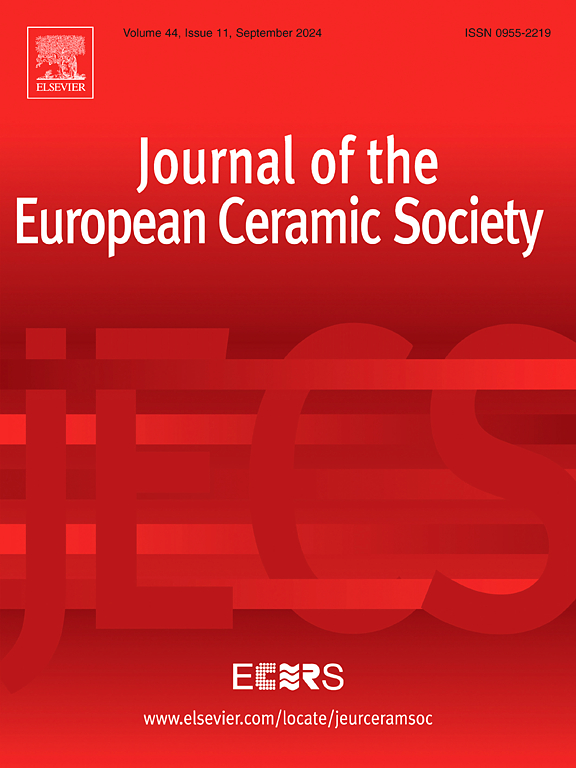Abrasion resistance and hardness of Cr-free zinc and iron co-doped spinel and magnesia-spinel refractory matrices for copper smelting
IF 6.2
2区 材料科学
Q1 MATERIALS SCIENCE, CERAMICS
Journal of The European Ceramic Society
Pub Date : 2025-05-18
DOI:10.1016/j.jeurceramsoc.2025.117545
引用次数: 0
Abstract
Abrasion resistance is one of the least studied properties of refractories despite its significant contribution to wear mechanisms. This work investigated the abrasion resistance and Vickers hardness of ZnO+Fe2O3 (3:1 by weight) doped alumina-rich spinel and magnesia-spinel that contained multicomponent (Mg,Zn)[Al,Fe]2O4 spinel as a major and minor phase, respectively. Sintered Al2O3, MgO-stabilized ZrO2 and MgO were used as standard reference refractory raw material aggregates for comparison. Stationary samples at room temperature were rubbed against a vertically rotating rubber lined wheel on which SiC particles were fed. This abrasion test revealed that (Mg,Zn)[Al,Fe]2O4 spinel occurring as individual grains along with sub-micron precipitates within magnesia grains increase abrasion resistance as compared to MgO. Microstructure of abraded surfaces identified wear mechanisms like microcracking, grain pullout formed craters, abrasion grooves and scraped patches. 3 wt% doped magnesia-spinel and 34 wt% doped alumina-rich spinel were found to be promising wear resistant matrix compositions to make environment-friendly chromium-free refractories for the copper industry.
铜冶炼用无铬锌铁共掺尖晶石和镁尖晶石耐火材料基体的耐磨性和硬度
耐磨性是耐火材料中研究最少的性能之一,尽管它对磨损机制有重要贡献。本文研究了ZnO+Fe2O3(重量比3:1)掺杂富铝尖晶石和含多组分(Mg,Zn)[Al,Fe]2O4尖晶石的镁尖晶石的耐磨性和维氏硬度。以烧结Al2O3、MgO稳定ZrO2和MgO作为标准耐火原料骨料进行比较。在室温下,将静止的样品与垂直旋转的内衬橡胶轮摩擦,并将SiC颗粒喂上。该磨损试验表明,(Mg,Zn)[Al,Fe]2O4尖晶石以单个晶粒的形式出现,并在氧化镁晶粒中形成亚微米沉淀物,与MgO相比,耐磨性提高。磨损表面的微观结构确定了微裂纹、颗粒拉出形成的陨石坑、磨损槽和刮擦斑块等磨损机制。发现3 wt%掺镁尖晶石和34 wt%掺富铝尖晶石是很有前途的耐磨基体成分,可用于铜工业生产环保型无铬耐火材料。
本文章由计算机程序翻译,如有差异,请以英文原文为准。
求助全文
约1分钟内获得全文
求助全文
来源期刊

Journal of The European Ceramic Society
工程技术-材料科学:硅酸盐
CiteScore
10.70
自引率
12.30%
发文量
863
审稿时长
35 days
期刊介绍:
The Journal of the European Ceramic Society publishes the results of original research and reviews relating to ceramic materials. Papers of either an experimental or theoretical character will be welcomed on a fully international basis. The emphasis is on novel generic science concerning the relationships between processing, microstructure and properties of polycrystalline ceramics consolidated at high temperature. Papers may relate to any of the conventional categories of ceramic: structural, functional, traditional or composite. The central objective is to sustain a high standard of research quality by means of appropriate reviewing procedures.
 求助内容:
求助内容: 应助结果提醒方式:
应助结果提醒方式:


